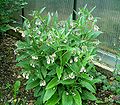Symphytum officinale
| Symphytum officinale subsp. var. | Comfrey, Common comfrey, English comfrey | |||||||||||||||||||||||||||||||||||||||||||||||||||||||
|---|---|---|---|---|---|---|---|---|---|---|---|---|---|---|---|---|---|---|---|---|---|---|---|---|---|---|---|---|---|---|---|---|---|---|---|---|---|---|---|---|---|---|---|---|---|---|---|---|---|---|---|---|---|---|---|---|

|
|
| ||||||||||||||||||||||||||||||||||||||||||||||||||||||
| ||||||||||||||||||||||||||||||||||||||||||||||||||||||||
Comfrey (Symphytum officinale L.) is a perennial herb of the family Boraginaceae with a black, turnip-like root and large, hairy broad leaves that bears small bell-shaped white, cream, light purple or pink flowers. It is native to Europe, growing in damp, grassy places, and is widespread throughout Ireland and Britain on river banks and ditches. Comfrey has long been recognised by both organic gardeners and herbalists for its great usefulness and versatility; of particular interest is the “Bocking 14” cultivar of Russian Comfrey (Symphytum x uplandicum).
| Standard Cyclopedia of Horticulture |
|---|
|
Symphytum officinale, Linn. (S. bohemicum, F. W. Schmidt). Perennial, about 3 ft. high: root thick: st. branched, white-pilose: lvs. slightly pilose, basal and lower cauline ovate - lanceolate, upper oblong-lanceolate, all broadly decurrent at base: fls. white, yellowish, purple, or rose, in drooping cymes. Eu., Asia. Var. argenteum, Hort., is offered in the trade as growing 2 ft. high, with silver-variegated foliage and drooping blue fls. Var. aureum, Hort., is offered in the trade as a golden variegated form growing 2 ft. high. Var. coccineum, Hort. (S. coccineum, Hort., ex Schlecht.), is offered in the trade as a scarlet-fld. form. Var. lilacinum, Hort., is offered in the trade. Var. purpureum, Pers. (S. officinale var. bohemicum, Don), has reddish purple fls. Eu. Var. variegatum, Hort., has lvs. widely margined with creamy white. F.S. 18:1901-1902. CH
|
Cultivation
Propagation
Pests and diseases
Varieties
Gallery
-
photo 1
-
photo 2
-
photo 3
References
External links
- w:Symphytum officinale. Some of the material on this page may be from Wikipedia, under the Creative Commons license.
- Symphytum officinale QR Code (Size 50, 100, 200, 500)


